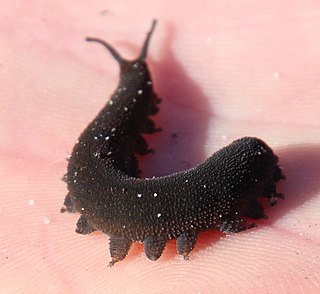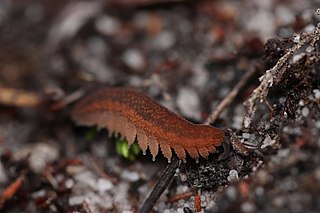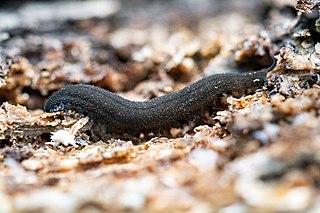
Peripatopsis is a genus of South African velvet worms in the Peripatopsidae family. The number of legs in this genus ranges from as few as 16 pairs to as many as 25 pairs and varies within species when the number is greater than 18 pairs. Velvet worms in this genus feature a last pair of legs that is rudimentary or reduced in size, mainly in males. This genus exhibits matrotrophic viviparity, that is, mothers in this genus retain eggs in their uteri and supply nourishment to their embryos, but without any placenta.

Peripatopsidae is one of the two living velvet worm families.
Opisthopatus cinctipes is a species of velvet worm in the Peripatopsidae family. This species has 16 pairs of legs, all with claws and all used for walking. Females range from 7 mm to 50 mm in length, whereas males range from 6 mm to 36 mm. Like other velvet worms in this genus, this species exhibits matrotrophic viviparity, that is, mothers in this genus retain eggs in their uteri and supply nourishment to their embryos, but without any placenta. The type locality is in South Africa.
Opisthopatus amatolensis is a species of velvet worm in the Peripatopsidae family. This species has 16 pairs of legs. The type locality is in South Africa. The validity of this species is uncertain: Although some authorities deem O. amatolensis to be invalid even as a subspecies of O. cinctipes, a similar species also found in South Africa, other authorities recognize O. amatolensis as a separate species, citing the significant distance between the type localities of these two species.
Opisthopatus laevis is a species of velvet worm in the Peripatopsidae family. This species has 16 pairs of legs. The type locality is in South Africa. The validity of this species is uncertain: Some authorities consider O. laevis invalid even as a subspecies of O. cinctipes, a similar species also found in South Africa, but other authorities recognize O. laevis as a separate species, citing the significant distance between the type localities of these two species.
Opisthopatus natalensis is a species of velvet worm in the Peripatopsidae family. This species has 16 pairs of legs. The type locality is in South Africa. The validity of this species is uncertain: Although some authorities have deemed O. natalensis to be a subspecies of O. cinctipes, a similar species also found in South Africa, and others regard O. natalensis as invalid even as a subspecies, still other authorities recognize O. natalensis as a separate species, citing the significant distance between the type localities of these two species.
Cephalofovea tomahmontis is a species of velvet worm in the Peripatopsidae family. This species is ovoviviparous, has 15 pairs of oncopods (legs), and lives in rotting logs and leaf litter. The type locality is Mount Tomah, New South Wales, Australia, after which this species is named. Like all members of the genus Cephalofovea, both sexes of C. tomahmontis have a furrow on the head, between the antennae, which the male everts to carry his spermatophore to the female.
Paraperipatus novaebritanniae is a species of velvet worm in the Peripatopsidae family. This species is black with brown-yellow spots. Females of this species have 24 pairs of legs; males have 22 or 23 leg pairs. Females range from 14 mm to 55 mm in length, whereas males range from 14 mm to 26 mm. The type locality is in New Britain, Papua New Guinea.
Paraperipatus papuensis is a species of velvet worm in the Peripatopsidae family. This species is a pale greenish blue. Females of this species may have as few as 21 pairs of legs or as many as 29 pairs, exhibiting the greatest intraspecific variation in leg number found in any peripatopsid species. Males of this species range from 21 to 27 leg pairs. The maximum number of leg pairs recorded in this species (29) is also the maximum number of leg pairs found in the family Peripatopsidae. Females range from 22 mm to 83 mm in length, whereas males range from 19 mm to 45 mm. The type locality is in Western New Guinea, Indonesia.
Paraperipatus lorentzi is a species of velvet worm in the Peripatopsidae family. This species is a dark green-blue. Females of this species have 22 to 28 pairs of legs; males have 21 or 22 pairs of legs. Whereas the original description of this species records 19 mm as the length of a male specimen, females range from 33 mm to 60 mm in length. The type locality is in Western New Guinea, Indonesia. The validity of this species is uncertain: Although some authorities deem P. lorentzi to be a junior synonym of P. papuensis, a similar species also found in Western New Guinea, others recognize them as two separate species.
Paraperipatus vanheurni is a species of velvet worm in the Peripatopsidae family. This species ranges from pale blue or lilac to dark purple in color. Females of this species have 25 to 27 pairs of legs; males have 21. This species ranges from 15 mm to 60 mm in length. The type locality is in Western New Guinea, Indonesia.
Peripatopsis balfouri is a species of velvet worm in the Peripatopsidae family. This species has 18 pairs of clawed legs. Specimens range from 9 mm to 22 mm in length. The type locality is in South Africa.

Peripatopsis capensis is a species of velvet worm in the Peripatopsidae family. This species has 18 pairs of legs: 17 pregenital leg pairs with claws plus one strongly reduced last pair without claws or spinous pads. Females of this species range from 9 mm to 70 mm in length, whereas males range from 6 mm to 54 mm. The native range of this species is limited to the Cape Peninsula of South Africa.

Peripatopsis lawrencei is a species of velvet worm in the Peripatopsidae family. This species has 18 pairs of legs: 17 pregenital leg pairs plus one last pair that is strongly reduced and without claws or spinous pads. This species is restricted to the Theewaterskloof-Overstrand region of South Africa.

Peripatopsis moseleyi is a species of velvet worm in the Peripatopsidae family. Males of this species have 20 to 24 pairs of legs with claws ; females have 19 to 23 pairs of legs with claws. Females range from 11 mm to 75 mm in length, whereas males range from 9 mm to 50 mm. The type locality is in South Africa.
Peripatopsis sedgwicki is a species of velvet worm in the Peripatopsidae family. Also known as the Tsitsikamma velvet worm, this species varies from blue-tan green to bright orange and brown violet. The number of legs in this species ranges from 19 pairs to 23 pairs, with a claw present on the genital pair and the last pair reduced more in the male than in the female. Females of this species range in size from 12 mm to 68 mm in length, whereas males range from 10 mm to 46 mm in length. Like other velvet worms in this genus, this species exhibits matrotrophic viviparity, that is, mothers in this genus retain eggs in their uteri and supply nourishment to their embryos, but without any placenta. The type locality is in South Africa. This species has a limited geographic distribution but is especially abundant in the indigenous forest of the Tsitsikamma mountains.

Peripatopsis overbergiensis, the Overberg velvet worm, is a species of velvet worm in the Peripatopsidae family. This species usually has 19 pairs of legs: 18 pregenital leg pairs plus one last pair that is strongly reduced and without claws or spinous pads. Some individuals, however, have only 18 leg pairs. This species is limited to the Overberg region of South Africa.

Peripatopsis alba, the white cave velvet worm, is a species of velvet worm in the family Peripatopsidae. This species has 18 pairs of clawed legs, with the last pair reduced, and no eyes. Specimens range from 32 mm to 48 mm in length. Like other velvet worms in this genus, this species exhibits matrotrophic viviparity, that is, mothers in this genus retain eggs in their uteri and supply nourishment to their embryos, but without any placenta.
Peripatopsis leonina, the Lion's Hill velvet worm, is a species of velvet worm in the Peripatopsidae family. This species has 20 to 24 pairs of legs, usually 21 or 22 leg pairs, with the last pair of legs reduced. Females of this species range from 7 mm to 41 mm in length, whereas males range from 7 mm to 34 mm.
Opisthopatus herbertorum is a species of velvet worm in the Peripatopsidae family. The type locality is in South Africa. As originally described, this species is uniformly white with 17 pairs of legs. Subsequent phylogenetic results, however, cast doubt on this species delimitation based on morphology, indicating instead that O. herbertorum is a junior synonym of O. roseus.






